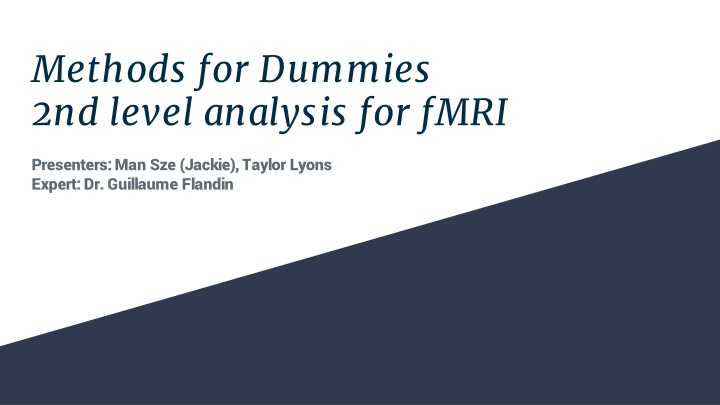
2nd Level fMRI Analysis: Fixed vs. Random Effects
Delve into the world of 2nd level fMRI analysis with a focus on Fixed and Random (Mixed) Effects models. Learn how to analyze group data to uncover significant effects not visible at the individual level. Explore the advantages and disadvantages of Fixed Effect Analysis versus Random Effects Analysis, and gain insights into how these methods impact research outcomes in fMRI studies.
Download Presentation

Please find below an Image/Link to download the presentation.
The content on the website is provided AS IS for your information and personal use only. It may not be sold, licensed, or shared on other websites without obtaining consent from the author. If you encounter any issues during the download, it is possible that the publisher has removed the file from their server.
You are allowed to download the files provided on this website for personal or commercial use, subject to the condition that they are used lawfully. All files are the property of their respective owners.
The content on the website is provided AS IS for your information and personal use only. It may not be sold, licensed, or shared on other websites without obtaining consent from the author.
E N D
Presentation Transcript
Methods for Dummies 2nd level analysis for fMRI Presenters: Man Sze (Jackie), Taylor Lyons Expert: Dr. Guillaume Flandin
Overview Recap on 1st level analysis 2nd level analysis Fixed, Random (Mixed) Effects Hierarchical model, Summary statistics Demo QnA
1st level analysis: individual analysis
Last lecture on 1st level analysis 1. Basis Functions - Model the fMRI signal 2. Parametric Modulation - Attributes of the tasks 3. Correlated Regressors - Multicollinearity
Find presence of significant effect in the group level, not individual level 2nd level analysis: group analysis 1. finding average beta value 2. how much the effect varies 3. what are the sources of these effects How? - Fixed effects - Random effects
Fixed Effect Analysis - Combine all data points from all subjects into a single analysis - Assume effect is constant - One t-test for all data points
N: 12 subjects each with 50 scans = 600 scans c = [4, 3, 2, 1, 1, 2, 3, 3, 3, 2, 4, 4] Fixed Effect Analysis Within subject variability: w2= [0.9, 1.2, 1.5, 0.5, 0.4, 0.7, 0.8, 2.1, 1.8, 0.8, 0.7, 1.1] Example Mean group effect (M) = 2.67 Mean w2= 1.04 Standard Error Mean (SEM) = w2/ sqrt(N) = 0.04 t = M/SEM = 62.7, p = 10-51
Advantages Fixed Effect Analysis - Simple Model - High degrees of freedom Disadvantages - Assumption of common variance - Sensitive to extreme results from individual subjects - Can t generalize findings to population
- Different effects the experimental manipulation on different individuals - response magnitude Random Effects Analysis (a.k.a Mixed Effects Analysis) - Based on how participants are drawn randomly from the population - Make inference
- Estimate subject and group stats at the same time via iterative looping Hierarchical models - Highly accurate - Computationally intensive
Summary Statistics - Step-by-step model - 1st level: fixed - 2nd level: random
Summary Statistics N = 12 subjects c = [4,3,2,1,1,2,3,3,3,2,4,4] Example Mean group effect (M) = 2.67 Between subject variability (SD) b2= 1.07 Standard Error Mean (SEM) = b2 /(sqrt(N))=0.31 t = M/SEM = 8.61, p = 10-6
N: 12 subjects each with 50 scans = 600 scans Fixed Effect Analysis c = [4, 3, 2, 1, 1, 2, 3, 3, 3, 2, 4, 4] Within subject variability: w2= [0.9, 1.2, 1.5, 0.5, 0.4, 0.7, 0.8, 2.1, 1.8, 0.8, 0.7, 1.1] Example Mean group effect (M) = 2.67 Mean w2= 1.04 Standard Error Mean (SEM) = w2/ sqrt(N) = 0.04 t = M/SEM = 62.7, p = 10-51
Summary 2nd level analysis - Fixed vs Random (Mixed) Effects - Hierarchical models - Summary Statistics
Thanks! Helpful resources: Principles of fMRI channel on Youtube: https://www.youtube.com/channel/UC_BI by85hZmcItMrkAlc8eA SPM videos: https://www.fil.ion.ucl.ac.uk/spm/course/ video/#Group Advanced readings on mixed models: Mixed-effects and fMRI studies by Friston et al., 2004













